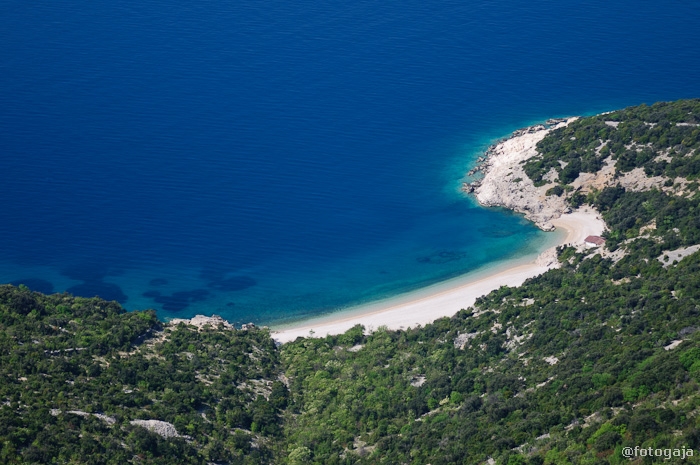At first I have to apologise to Croatians. The cache description
shold be in Croatian and English. I deceided to use English only,
because my knowledge of Croatian is not good enough (it would be
some sort of Croatian-Slovenian mix) and I really do not want sth
like that published.
CACHE INFO
This cache is hidden near the beach of Sv. Ivan, one of the most
beautiful beaches on the island Cres. You can visit the beach
either by car (by car to Lubenice and then on foot from Lubenice to
the beach), or by boat. You will have to walk 45 min downhill and
about an hour uphill in the first case, and vice versa in the
second case. You can not skip walking even if you come by boat,
because to get the missing data you have to visit the village
Lubenice. Good walking shoes are necessary.
Do take some time for bathing and sun-bathing and do not forget
to bring drinking water (especially if visiting on
foot from Lubenice) because you can not get any at the bay.
I suggest you start looking for the cache at the reference point
B (because of the bushy terrain) and then follow the little stony
man (look at the pic) showing you the direction.
And not least but last a little help for those who will come by
boat and really hate walking (it is worth it
though). By using some math (more common sense than math I
guess) and given data the missing x (0<=x<=9; x is integer)
can be determined (two solutions). No, and I am not going to tell
you which one of the two solutions is the right one. I guess you
will have to walk a bit anyway.
Happy hunting. Gamsi
UVALA SV. IVAN
One of the most beautiful beaches on island Cres is the
beach Sv. Ivan, which is located in a bay beneath the
settlement Lubenice. A magnificent view from the narrow cliffs
discovers beautiful white pebbly beach to which you can get by
narrow paths from Lubenice or by boat.

LUBENICE
Lubenice is a fortified urban settlement from
prehistoric times which is confirmed by the surrounding tumuli from
the Bronze and Iron ages that have been found. It has continuously
been settled throughout the ancient times and middle Ages. Among
the existing built structures, along with medieval sacral
buildings, a dominant role is played by structures that have a high
ambience quality and are mostly from the period of the baroque.
However, in the substructures and details of the houses, as well as
in their proportions a medieval layer is visible. Of special value
are the remains of the medieval fortifications and two city gates,
as well as the preserved historic core and the land composition of
the settlement. Historically, Lubenice is a prehistoric, well
fortified and strategically very important city. In ancient times
it was mentioned as Hibernitia (a winter, cold settlement) to which
a branch road of the main Roman road from Osor to Beli led. At that
time it was one of the four most important settlements on the
island of Cres with a fully formed center that was urban in
character. At the foot of the settlement there is an important
villa rustica with a broader agricultural area and a port that
belonged to the settlement and wider region. Numerous
archaeological material finds (sarcophagus, Egyptian inscriptions,
....., amphora and other building materials, as well as coins,
jewelry, etc.) undoubtedly date the origins of this settlement to
ancient time. In the middle Ages the city was fortified once again
and became the center of the parish. The settlement is of an
irregular, elongated, oval layout with a number of house
agglomerations. Two longitudinal streets transversely connected
with small, covered arched passages stand out. The city fortress
wall with occasional structures incorporated within it is preserved
on the eastern side as are the northern and southern city gates.
The communication lines are uneven, sporadically paved with broken
stones. A number of structures are organized around courtyards
which are entered into through stone portals.

Today, Lubenice is a small local center with approximately 40
buildings and 24 permanent inhabitants. The monumental vernacular
architecture with stone water reservoirs that are accessed by stone
stairs is exceptionally well preserved. An example of a water
reservoir located on second floor level is likewise preserved. In
addition, there are monumental chimneys of exceptional dimensions
and shapes as well as other elements of rural architecture (bread
stoves, horns for drying fruit, traditionally shaped eaves and
wooden pergolas). The specific character of this settlement, as an
urban-rural complex is reflected in certain urban style houses with
urban water reservoirs and facade distinctions. The other urban
elements also include the city loggia situated along the bell tower
of the parish church, a square with a communal cistern and already
mentioned city gates, parish church, cemetery and a number of
medieval chapels (chapel of St. Dominic, restored chapel of St.
Anthony of the Desert, chapel of St James and St Barbara and chapel
of St Stephen in the cemetery).
The fusion of the settlement into the surrounding humanized
landscape is certainly one of its more important aspects. The
settlement is situated on a high cliff and constructed of the same
material making it an almost natural amalgamation of man-made and
natural elements while the natural characteristics of the area are
reflected in the very name of the city (Hibernitia / cold, winter
settlement).